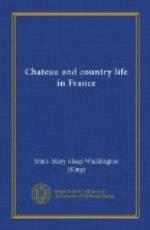The park is splendid, a real domain, all the paths and alleys beautifully kept and every description of tree—M. de Courval was always trying experiments with foreign trees and shrubs and apparently most successfully. I think the park would have been charming in its natural state, as there was a pretty little river running through the grounds and some tangles of bushes and rocks that looked quite wild—it might have been in the middle of the forest but everything had been done to assist nature. There were a “piece d’eau,” cascades, little bridges thrown over the river in picturesque spots, and on the highest point a tower (donjon), which was most effective, looked quite the old feudal towers of which so few remain now. They were used as watch towers, as a sentinel posted on the top could see a great distance over the plains and give warning of the approach of the enemy. As the day was fine—no mist—we had a beautiful view from the top, seeing plainly the great round tower of Coucy, the finest ruin in France—the others made out quite well the towers of the Laon Cathedral, but those I couldn’t distinguish, seeing merely a dark spot on the horizon which might have been a passing cloud.
Coming back we crossed the “Allee des Soupirs,” which has its legend like so many others in this country: It was called the “Allee des Soupirs” on account of the tragedy that took place there. The owner of the chateau at that time—a Comte de Lamothe—discovered his wife on too intimate terms with his great friend and her cousin; they fought in the Allee, and the Comte de Lamothe was killed by his friend. The widow tried to brave it out and lived on for some time at the chateau; but she was accursed and an evil spell on the place—everything went wrong and the chateau finally burnt down. The place was then sold to the de Courval family.
At the end of an hour the Marquise had had enough; I should not think she was much of a walker; she was struggling along in high-heeled shoes and proposed that she and I should return to the house and she would show me her atelier. W. and Mme. de Courval continued their tour of inspection which was to finish at the Home Farm, where she wanted to show him some small Breton cows which had just arrived. The atelier was a charming room; panelled like all the others in a light grey wood. One hardly saw the walls, for they were covered with pictures, engravings and a profusion of mirrors in gilt oval frames. It was evidently a favourite haunt of the Marquise’s: books, papers and painting materials scattered about; the piano open and quantities of music on the music-stand; miniatures, snuff-boxes and little old-fashioned bibelots on all the tables, and an embroidery frame, of course, in one of the windows, near it a basket filled with bright coloured silks. The miniatures were, almost all, portraits of de Courvals of every age and in every possible costume: shepherdesses, court ladies of the time of Louis XV, La Belle Ferronniere with the jewel on her forehead, men in armour with fine, strongly marked faces; they must have been a handsome race. It is a pity there is no son to carry on the name. One daughter-in-law had no children; the other one, born an American, Mary Ray of New York, had only one daughter, the present Princesse de Poix, to whom Pinon now belongs.




